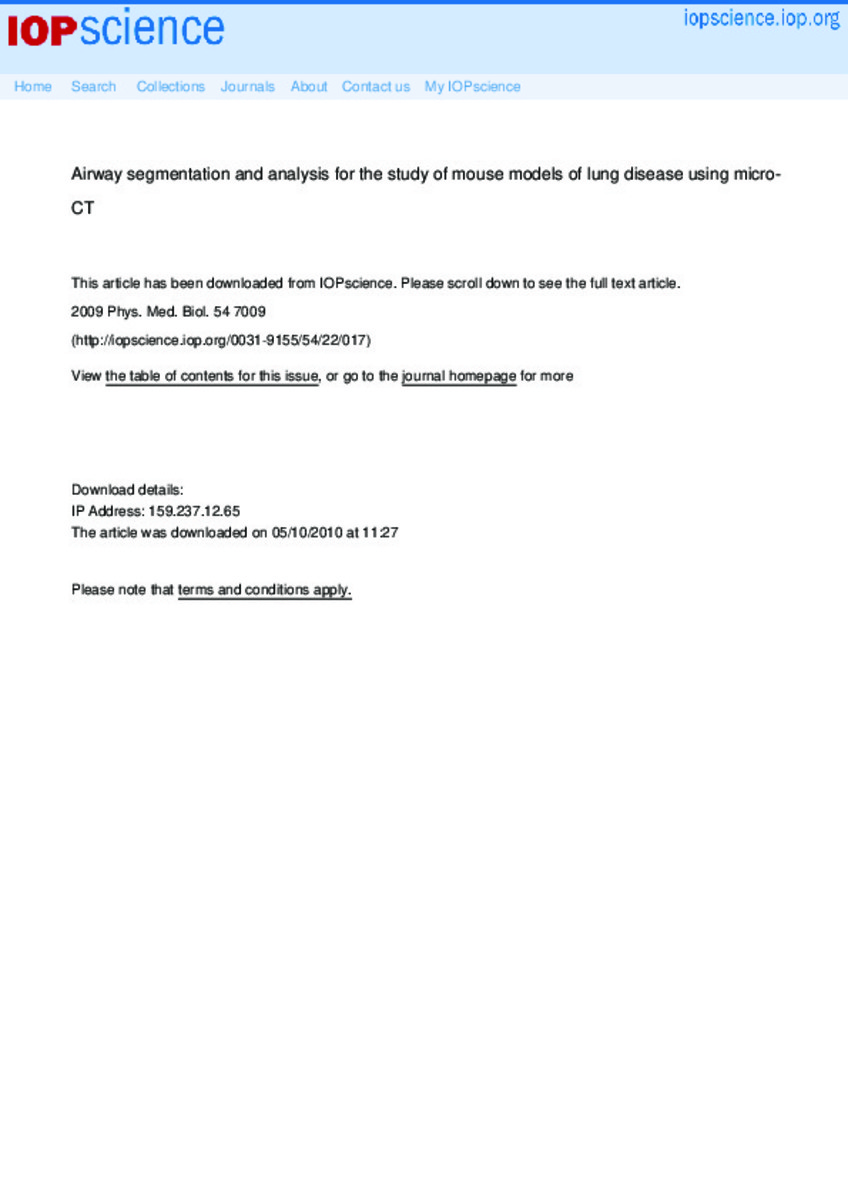Full metadata record
| DC Field | Value | Language |
|---|---|---|
| dc.creator | Artaechevarria-Artieda, X. (Xabier) | - |
| dc.creator | Perez-Martin, D. (Daniel) | - |
| dc.creator | Ceresa, M. (M.) | - |
| dc.creator | Biurrun, G. (Gabriel) de | - |
| dc.creator | Blanco, D. (D.) | - |
| dc.creator | Montuenga-Badia, L.M. (Luis M.) | - |
| dc.creator | Ginneken, B. (B.) van | - |
| dc.creator | Ortiz-de-Solorzano, C. (Carlos) | - |
| dc.creator | Muñoz-Barrutia, A. (Arrate) | - |
| dc.date.accessioned | 2010-10-19T07:55:47Z | - |
| dc.date.available | 2010-10-19T07:55:47Z | - |
| dc.date.issued | 2009-11-04 | - |
| dc.identifier.citation | Artaechevarria X, Perez-Martin D, Ceresa M, de Biurrun G, Blanco D, Montuenga LM, et al. Airway segmentation and analysis for the study of mouse models of lung disease using micro-CT. Phys Med Biol 2009 Nov 21;54(22):7009-7024. | es_ES |
| dc.identifier.issn | 0031-9155 | - |
| dc.identifier.uri | https://hdl.handle.net/10171/13522 | - |
| dc.description.abstract | Animal models of lung disease are gaining importance in understanding the underlying mechanisms of diseases such as emphysema and lung cancer. Micro-CT allows in vivo imaging of these models, thus permitting the study of the progression of the disease or the effect of therapeutic drugs in longitudinal studies. Automated analysis of micro-CT images can be helpful to understand the physiology of diseased lungs, especially when combined with measurements of respiratory system input impedance. In this work, we present a fast and robust murine airway segmentation and reconstruction algorithm. The algorithm is based on a propagating fast marching wavefront that, as it grows, divides the tree into segments. We devised a number of specific rules to guarantee that the front propagates only inside the airways and to avoid leaking into the parenchyma. The algorithm was tested on normal mice, a mouse model of chronic inflammation and a mouse model of emphysema. A comparison with manual segmentations of two independent observers shows that the specificity and sensitivity values of our method are comparable to the inter-observer variability, and radius measurements of the mainstem bronchi reveal significant differences between healthy and diseased mice. Combining measurements of the automatically segmented airways with the parameters of the constant phase model provides extra information on how disease affects lung function. | es_ES |
| dc.language.iso | eng | es_ES |
| dc.publisher | Institute of Physics | es_ES |
| dc.rights | info:eu-repo/semantics/openAccess | es_ES |
| dc.subject | Airway segmentation moanalysis | es_ES |
| dc.subject | Micro-CT X | es_ES |
| dc.subject | Models of lung | es_ES |
| dc.subject | Diseases | es_ES |
| dc.title | Airway segmentation and analysis for the study of mouse models of lung disease using micro-CT | es_ES |
| dc.type | info:eu-repo/semantics/article | es_ES |
| dc.identifier.doi | http://dx.doi.org/10.1088/0031-9155/54/22/017 | es_ES |
Files in This Item:
Statistics and impact
Items in Dadun are protected by copyright, with all rights reserved, unless otherwise indicated.






